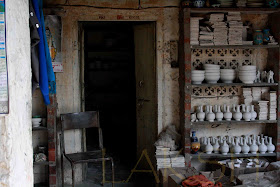
A post long overdue.
Visit to Rajasthan becomes an intention and all the more interesting during winters.
Last visit to Rajasthan ,was to Jaipur and visiting Sanganer was one among our itineries..
We enjoyed being among the world of blue pottery factories and pots and block prints...
Some behind the scenes from the factory
Origin
Blue pottery though Turko-Persian in origin, is widely recognized as a traditional craft of Jaipur. Legend has it that blue pottery came to Jaipur in the early 19th century when one of its rulers, Sawai Ram Singh II (1835 – 1880) set up a school of Art and encouraged artists and craftsmen from all over the country to come and settle here – a tradition started by his fore-fathers. Blue pottery has seen several ups and downs in its lie span of almost 200 years. There was a time when it all but vanished from Jaipur but the efforts of several concerned people like Smt. Kamla Devi Chattopadhaya and Ramata Gaytri Devi helped to revive this dying art.
Today, blue pottery is a growing industry, an industry that provides livelihood to thousands of people.
The Process
Blue Pottery is based on ground quartz. The dough is pressed into moulds and the unfired pieces are hand painted with oxide colours, dipped in clear glaze and fired once in wooden kilns. The process is very tedious and time consuming. Once made, the blue pottery items cannot be reworked. It is a craft where one is never sure if the finished product will have the exact shade that one may have wanted. The smallest mistake could lead to the piece either cracking up or turning black.This tedious process was one of the main reasons why very few people were willing to experiment and try out new products in blue pottery. Not only did it require time and patience but also money. Blue pottery survived as a decorative item – ideal for gifts and souvenirs. But its practical use was very limited.
The Jaipur mix usually contains no clay at all. It is made up of 100 kg (220lbs) of ground quartz, 10-20 kg (22-44 lbs) of green glass, ½ kg (I lb) of fuller’s earth ½ kg (I lb) of borax and 1 kg (2.2lbs) of gum. This is kneaded into a dough, flattened and pressed into an open mould. A vase, for example, will be made up in four parts; a wheel-turned neck; two moulded hemispheres; and a wheel-turned base. The hemispheres are filled with ash or sawdust while they dry, the parts are joined and the surface smoothed over, and the vase is then taken for painting. The outlines are drawn in cobalt oxide using a squirrel-tail brush (little ground squirrels are frequently run
over, and the painters collect the tails, from which they make their own brushes).





























The design is filled in with other metal oxides, each of which is transformed into a bright colour by firing. The oxide of cobalt becomes a deep blue, that of chromium changes to green, cadmium produces a bright yellow and iron oxide becomes a red-brown. The piece is then dipped into a homemade glaze of glass, borax and lead oxide which is made adhesive by the addition of boiled flour. When enough dried pieces have built up they are fired at 800 - 850o C for six hours in a closed kiln fuelled with charcoal. All the melts, but 80 per cent of the quartz is left, and this maintains the form of the vessel. The kiln is left to cool for three days, avoiding any rapid temperature change which so easily cracks the china.






Images and Ideas conceived By Lakshmi Arvind
Pl dont steal or copy images

What a lovely and informative post. I spent many years in Rajasthan..so makes me feel very nostalgic.
ReplyDeleteVery nice, Lakshmi. You have given so much detail in this post. Love all the photographs too.
ReplyDeleteThanks Anu and Preoccupied,for the lovely comments.
ReplyDeleteAnu:U were in Rajasthan...couldnt believe
Preoccupied:thanks for loving my images
Beautiful! Loved the post and the pictures. I hope through this post people realize how much work an artisan puts in to create a single piece.
ReplyDeleteHi Lakshmi,
ReplyDeletevery interesting article and well illustrated with the lovely pictures. Thanks for bringing it to us :-)
That's a lovely step by step detail about the art... Interesting...
ReplyDeleteCasa Florentia
Those are lovely pots and the designs are beautiful...
ReplyDeleteCan you tell me the address of this place..natasshakulkarni@gmail.com
ReplyDeleteCould you help me with the address natasshakulkarni@gmail.com
ReplyDeleteGood creativity, I like it!
ReplyDelete